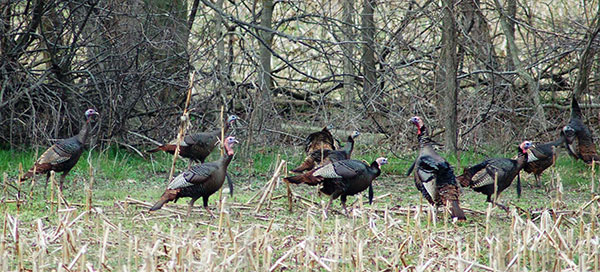By Louie Stout
 Turkey Group - Photo by David Hamrick
Turkey Group - Photo by David Hamrick
Photo by David Hamrick
Michiana turkey hunters who do their homework shouldn’t have much trouble locating gobblers this month.
The odds of success might be better in southern Michigan, ranked the 8th best turkey hunting state in the nation. Southwest Michigan’s season opened April 17 and runs through May 31, depending upon the type of license you purchase. You will need a base license and a turkey license.
A special youth season kicks off Indiana’s season April 22-23 followed by the regular opener April 26. Indiana’s spring hunt runs through May 14. The bag limit is one bearded or male turkey. You will need a turkey hunting license and gamebird habitat stamp.
The spring season is built around the mating season when gobblers are looking for hens to breed.
Although the region has turkeys, hunting these wary birds isn’t as simple as walking into the woods. Scouting an area beforehand certainly helps; more importantly, hunters must learn to be patient, stealthy and have some calling skills to draw the gobblers into range.
Indiana turkey biologist and South Bend native Steve Backs says northern Indiana turkey hunters can expect a season similar the past two.
Top turkey counties across northern Indiana last year, with the number of birds harvested shown in parenthesis, were Steuben (362), Marshall (278), LaGrange (259) and Starke (247). Closer to South Bend, St. Joseph took 185 birds, Elkhart 202, LaPorte 197 and Kosciusko 227.
In fact, the northern counties continue lead most other regions in the state.
“We haven’t had the impact of turkey population declines in the north like we have in the south,” Backs said. “We typically see a post-restoration decline in areas where the turkey population has grown and the birds have spread out.”
Statistics show that the number of poults a hen raises tends to diminish in areas where the birds are more established.
The northern half of Indiana was one of the last areas to get turkeys restored by the Indiana DNR.
“The north is still riding a high because the birds are still relatively new up there,” he added. “But it will happen when the expansion starts leveling off and we’ll start seeing a decline in natural production.”
Backs said he’s even starting to get a few complaints about turkeys from landowners. Some hunters are even asking for an increase in bag limits, but the biologist said it’s too early to do that, especially with the anticipated decline in forthcoming years.
Most of Indiana’s turkey hunting is done on private land. For more information about Indiana turkey hunting, visit http://www.in.gov/dnr/fishwild/8695.htm.
For Michigan turkey hunting, visit www.michigan.gov/dnr.




